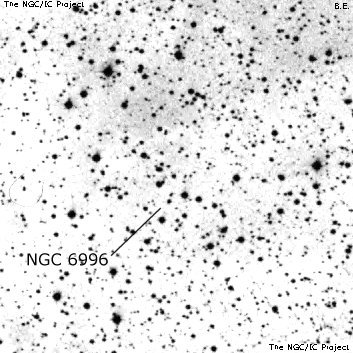NGC/IC Project Restoration Effort
(This is a very very beta version)
NGC6996


Basic Information
Location and Magnitude
Right Ascension: 20:56:30.0
Declination: +45:28:24
Constellation: CYG
Visual Magnitude: 10.0
Historic Information
Discoverer: Herschel J.
Year of discovery: 1828
Discovery aperture: 18.3
Observational
Summary description: Cl, P, lC
Sub-type: III2p
Corwin's Notes
=====
NGC 6996. This is a loose cluster, or rich region of the Milky Way, in the
northern part of the North America Nebula. It has often been confused with
NGC 6997 (which see) in the cluster catalogues, but the position from JH's
single observation seems to be pretty good.
However, JH was actually looking for his father's VIII 82, which eventually
entered the catalogues as NGC 6989 (which see). As I note there, the
positions that JH had when he was pulling together the GC are far enough apart
that he made two different clusters out of the observations.
I (1970, Griffith Observer) and Brent Archinal (1993, "non-existent" RNGC
clusters monograph) present observations and further discussions of these
objects.
Steve's Notes
=====
NGC 6996
18" (8/12/07): at 115x, ~40 stars mag 10-14 in a 6' region are mostly arranged in a "C" arrangement (or three sides of a rectangle), opening on the NW side. Stands out somewhat in the field but not striking. Located on the north (Canada) side of the North America Nebula. More interesting is that on the east side of the group and curving around the north side is a well-defined fairly high contrast dark nebula (Barnard 353). I had the impression that the stars in the "cluster" were perhaps an absorption hole in this dark cloud.
17.5" (9/23/95): about 50 stars mag 10 and fainter within an 8'-10' group in the northeast part of the North American nebula. Fairly well-detached and distinguishable in a low power field but appears to be a typical Milky Way cloud with no particular dense spots. Situated about 10' NW of a striking equilateral triangle of mag 8/9 stars with sides 2' (center at 20 57.0 +45 19). Barnard 353 (low contrast) is just following. The RNGC misidentifies NGC 6997 as NGC 6696.



